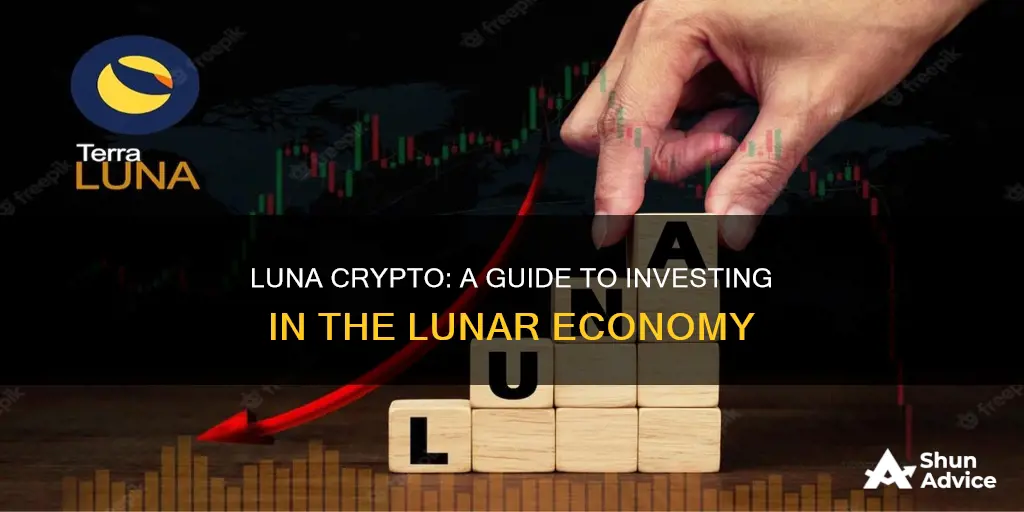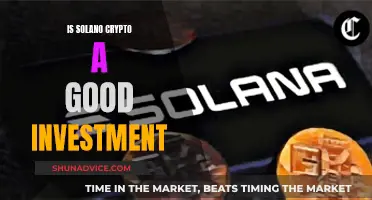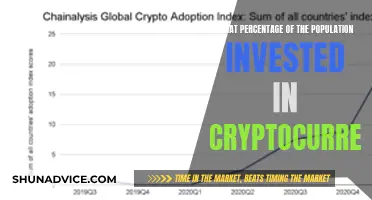
Luna is the native token of the Terra blockchain, which is a decentralised global payment system designed specifically for transferring stablecoins. Stablecoins are pegged to other currencies, such as USD, so payments on Terra don't fluctuate with the cryptocurrency markets. This limits the risk of buying volatile cryptocurrency while still providing the benefits of a decentralised payment system.
Luna is used to provide liquidity to the platform, as decentralised finance programs need their users to provide liquidity in their smart contracts. Terra offers rewards to incentivise users to stake Luna on its platform. Users can earn interest from transaction fees and arbitrage on Terra's platform.
While Luna has been described as being among the riskiest of cryptocurrencies by one expert, it did hit an all-time high of over $103 in 2021, and it started that year priced below $1.
What You'll Learn

Understanding the risks
Luna is the native token of the Terra blockchain, which is a decentralised financial infrastructure and blockchain protocol. Terra offers multiple stablecoin options that provide instant settlement.
Luna has been described as "among the riskiest of cryptocurrencies" by an expert. It is important to research and understand the risks before investing in Luna, as with any cryptocurrency. Here are some of the key risks to consider:
Volatility and Price Swings
Cryptocurrencies are known for their volatility, and Luna is no exception. The price of Luna can fluctuate significantly, and investors could face large price swings. Luna's value increased dramatically in 2021, rising from below $1 to over $100 in a single year. However, it is important to remember that these gains can also be lost just as quickly.
Regulatory Risk
The regulatory landscape for cryptocurrencies is still evolving, and there is a risk of regulatory changes that could impact the value of Luna. For example, the U.S. Securities and Exchange Commission (SEC) is currently investigating Terraform, the company behind the Terra blockchain, for potentially selling unregistered securities. This investigation relates to Terraform's Mirror Protocol, which offers synthetic versions of stocks. While the investigation is not directly related to the Terra protocol, it could still have implications for investors.
Stablecoin Risk
Luna is closely tied to Terra's stablecoins, particularly TerraUSD (UST). Stablecoins are designed to maintain a fixed value, usually pegged to a fiat currency like the US dollar. However, UST is an algorithmic stablecoin, which means it is not backed by actual dollars or assets in a bank. Instead, its value is derived from algorithms that link it to Luna. There is a risk that UST could lose its peg to the dollar, which could have a significant impact on the value of Luna. In May 2022, UST did indeed lose its peg, which led to a crash in the value of both UST and Luna. This event wiped out an estimated $60 billion from the digital currency space and caused widespread losses for investors.
Centralization
While Terra seeks to reduce centralization in the market by functioning across multiple blockchains, there is still a degree of centralization in the form of Terraform Labs and its co-founders, Do Kwon and Daniel Shin. The actions and decisions of these individuals can significantly impact the value of Luna. For example, following the collapse of the Luna network, an arrest warrant was issued for Do Kwon, and he was accused of violating local market laws.
Competition
The cryptocurrency market is highly competitive, and there are numerous other blockchain projects offering similar features to Terra. For example, Ethereum is the largest decentralised finance (DeFi) protocol and has a much larger number of DeFi protocols built on it compared to Terra. Increased competition could impact the adoption and value of the Terra network and Luna.
Best Cloud Storage Coins: Worthy Investment Options
You may want to see also

How to buy LUNA
LUNA is the native cryptocurrency of the Terra blockchain, which was created in 2019. The blockchain was designed to create stablecoins – cryptocurrencies whose values keep parity with fiat currencies such as – but not exclusively – the US dollar.
Users of the Terra network spend Luna tokens to validate transactions and to have a say in the future direction of the project. For example, they can choose which stablecoins will be minted next. When people spend Terra stablecoins, Luna holders receive a small fee.
If you want to buy Luna, you will need to open an online account with a crypto brokerage that supports Luna. The two most prominent cryptocurrency exchanges that support Terra in the US are Voyager and Gemini. To make an account with these exchanges, you will need to provide your name, Social Security number, address, email, and birth date.
You will also need to buy or download a crypto wallet. Cryptocurrency wallets can be software wallets (mobile apps or computer programs) or hardware wallets (physical devices that store your cryptocurrency offline).
Once you have chosen a crypto wallet to store your funds, you are ready to make your purchase. You can place your buy order for Luna as either a limit or market order. Market orders will purchase Luna at the current market price, while limit orders will execute at a specified price that you set.
The most reputable exchanges that support the trading of LUNA 2.0 are Pionex, Binance (for non-US investors), and Crypto.com.
Risks of Buying LUNA
All cryptocurrencies are volatile, and Luna is no different. If you had bought Luna this time last year, your investment would have lost 95% of its value.
The Financial Conduct Authority (FCA) considers this investment to be high risk. You could lose all the money you invest. The crypto market is generally unregulated, and there is a risk of losing money or crypto assets due to cyber-attacks, financial crime, and firm failure.
Brief History of Terra
The original version of Terra collapsed, bringing down the rest of the crypto market with it in 2022. In its place, a new protocol with many improvements was erected. The new coin, LUNA, replaced the old Terra Luna token (now called Terra Classic (LUNC)) on the new network.
IoTx Coin: A Good Investment or Just Hype?
You may want to see also

The benefits of Terra (LUNA)
Terra (LUNA) is a blockchain protocol for issuing algorithmic stablecoins and creating decentralized financial infrastructure. It offers multiple stablecoin options that provide instant settlement, lower fees, more stability, seamless cross-border exchanges, and highly responsive financial assets.
The network is designed to run on multiple chains, connected by the Cosmos IBC. It is currently live on Ethereum and Solana, with plans to expand to other top-performing blockchains in the future. This interoperability is a key benefit of Terra, allowing it to reduce centralization in the market and offer competitive programmable payments, logistics, and infrastructure.
Another advantage of Terra is its development-focused agenda. It allows programmers to build smart contracts in Rust, Go, or AssemblyScript, and to add extra functionality through the use of oracles. Oracles are off-chain sensors that communicate data to and from the blockchain, and they are critical for price discovery.
Terra also has a transparent ecosystem, aiming to replace the complicated payments value chain. It helps to reduce or remove the need for credit card networks, banks, and payment gateways with a single blockchain layer.
Additionally, Terra users can stake LUNA and earn rewards. Staking rewards are derived from gas fees, taxes, and seigniorage rewards. LUNA stakers benefit from the economic activity of expanding and contracting Terra stablecoin supplies.
Coinbase Company Investment: Registering Your Business Interest
You may want to see also

LUNA staking rewards
LUNA staking is a process where investors lock up their LUNA tokens to earn passive income. LUNA staking rewards come from a combination of gas (compute fees), taxes, and seigniorage rewards. A small percentage transaction fee ranging from 0.1% to 1% on every Terra transaction also contributes to these earnings for stakers.
Users can expect around a 6-7% annualized interest rate on their deposits, depending on how they participate in the staking process. This is far greater than any interest rate offered by traditional banks.
To stake LUNA, you can use the Terra Station Wallet – the official wallet software for holding Terra assets. First, connect and install the browser extension or desktop application. Then, create a new wallet by typing a username and password (keep them secure). Once you have the wallet, send LUNA tokens from an exchange to your Terra Station Wallet. After you have the tokens in the wallet, go to the staking tab and choose a validator to delegate your tokens to and earn yield by staking.
When choosing a validator, consider the following:
- The size of the stake pool: If the validator's fund size falls below 130th place in the rankings, all privileges will be stripped.
- The amount of self-bonded tokens: Coins that the validator owns and has pledged to stake.
- The amount of delegated tokens: The popularity of the validator and the number of coins committed to the fund.
- Commission fee: How much the validator deducts from the staking rewards before distributing them among delegators.
- Track record of the validator: How long the person has been running the node, their votes on proposals, and the history of outages, compromises, and attacks.
It's important to note that if you choose to stop staking, there is a 21-day waiting period before you will receive your tokens.
China's Crypto: How to Invest and Navigate the Market
You may want to see also

LUNA's role in the stablecoin ecosystem
LUNA is the native token of the Terra blockchain. Terra is a decentralised finance (DeFi) ecosystem that creates algorithmic stablecoins. Stablecoins are cryptocurrencies pegged to reserve assets like the US dollar and are frequently used in DeFi applications such as lending or borrowing.
LUNA plays a crucial role in the Terra ecosystem. It is used to operate the collateralising mechanisms that secure the price stability of the network's stablecoins. LUNA's elastic supply fluctuates according to the needs of Terra's collateralisation mechanism. When transaction volume increases, the demand for stablecoins like TerraUSD (UST) expands, and new LUNA coins are issued to maintain price stability. Conversely, when transaction volume decreases, Terra buys back and burns LUNA to reduce the supply.
LUNA is also used for staking, governance, and voting within the Terra protocol. As a staking utility coin, LUNA holders can stake their tokens to earn rewards. Additionally, LUNA holders have governance rights and voting power, allowing them to participate in the network consensus and vote on vital network updates.
The stability of Terra's stablecoins is maintained by internal algorithms and the LUNA token. When a stablecoin like UST drops below its pegged value, LUNA supplements the supply to help it maintain its peg to its underlying asset. This symbiotic relationship between LUNA and Terra's stablecoins ensures their mutual stability.
Finding a Bitcoin Miner: Where to Invest?
You may want to see also
Frequently asked questions
Luna is the native token of the Terra blockchain, which is a decentralized global payment system made specifically for transferring stablecoins.
You can invest in Luna by opening an online account with a crypto brokerage that supports Luna, such as Voyager or Gemini (for US residents). Then, you can buy or download a crypto wallet to store your cryptocurrency. Once you've done that, you can place a buy order for Luna as either a limit or market order.
Luna is considered one of the riskiest cryptocurrencies by experts. It is subject to the same volatility and speculation as other cryptocurrencies, and there is a potential for a collapse of the entire Terra ecosystem.







